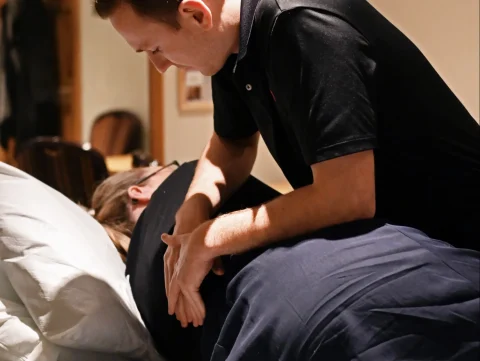FAQs
Do you have a question?
Search Our Faqs, Get your Answer.
If you don't see your question here, drop us a line on our contacts page.
GET IN TOUCH- Osteopaths are highly trained healthcare professionals who are experts in the musculoskeletal system (joints, muscles and associated tissues) and its relationship to other systems of the body. Osteopaths are statutorily regulated primary healthcare professionals, who work in the private healthcare and/or primary, secondary and tertiary care in NHS settings.
- All Osteopaths working in Britain are regulated by the General Osteopathic Council. They are required to successfully complete a Masters in Osteopathy in one of the accredited institutions. This includes over 1000 hours of successful supervised clinical practice.
- During your first appointment, your practitioner will ask you about your medical history and lifestyle, as well as any symptoms you may be experiencing. This is very important as it will help to make an accurate diagnosis and assist your practitioner to suggest appropriate treatment. They will then examine the areas of your body causing discomfort and will need to feel for any tightness in the soft tissues and stiffness in the joints and will need to touch those areas to identify problems. Your practitioner will explain what he is doing throughout your treatment. Please be aware the cause of your problem may be in a different area to the pain, for example, pain in your lower arm is often linked to the nerves in your neck, but don’t let this worry you as your practitioner will walk you through this to ensure you have a full understanding. Treatment typically involves several sessions of manual therapy designed to release tension, stretch and relax muscles and mobilise joints. Your practitioner may also use gentle visceral and cranial techniques to help return the body to optimal functioning. If you are uncomfortable with any part of this, you have the right to ask for the treatment to be stopped at any stage, without prejudicing your future treatment. Occasionally your practitioner may diagnose an illness which would better be treated by a different medical colleague. Your permission will always be sought before referring you for further investigations.
- Most of the techniques used are gentle and painless. The nature of your complaint however, might make you more sensitive to pain and your feedback is always valued if you find a particular treatment exacerbates your symptoms. Some patients experience a ‘treatment reaction’ while their body readjusts to the effects of the treatment. If this has not improved within 48-hours please ring for further support.
- Your practitioner will need to be able to see and physically examine areas of your body contributing to your complaint. We use drapes and towels to ensure your dignity at all times during treatment. Patients who prefer not to undress to their underwear are welcome to wear shorts, sports bra, or close-fitting garments.
- Young people under the age of 16 will only be treated with an accompanying adult. Everybody else is welcome to bring a trusted companion to their appointment.
- At the start of your first appointment, your practitioner will record information about your medical history and lifestyle, as well as any symptoms you may be experiencing. This is essential in helping to make an accurate diagnosis and for them to suggest appropriate treatment. Your records will be treated as confidential in accordance with standards of practice set out by the General Osteopathic Council and the General Data Protection Regulation (GDPR). If you wish, you may request a copy of your notes, but you may be charged an administration fee for this.


